The Best Chef’s Knives of 2023
We’ve reviewed and tested dozens of chef’s knives over the years. Unfortunately, there can only be 3 winners. Find our 3 best chef’s knives below, our reasons for choosing them, and learn more about each of them.
#1 – Zwilling J.A. Henckels Professional S Chef Knife
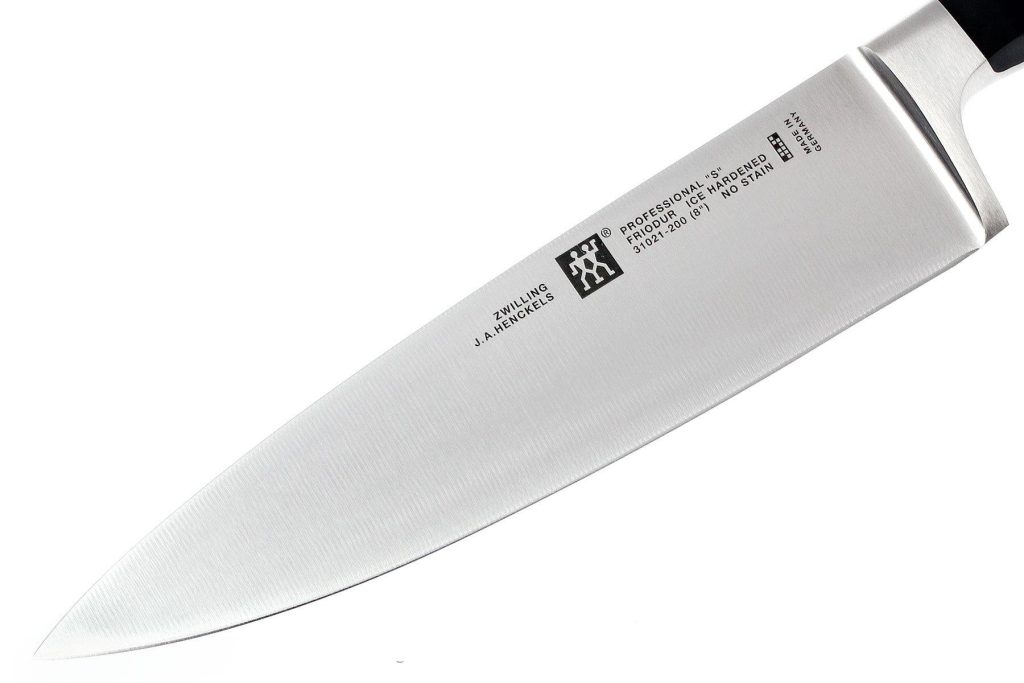
Our score:
5/5
#2 – Wusthof Classic Santoku – Japanese-Style Knife
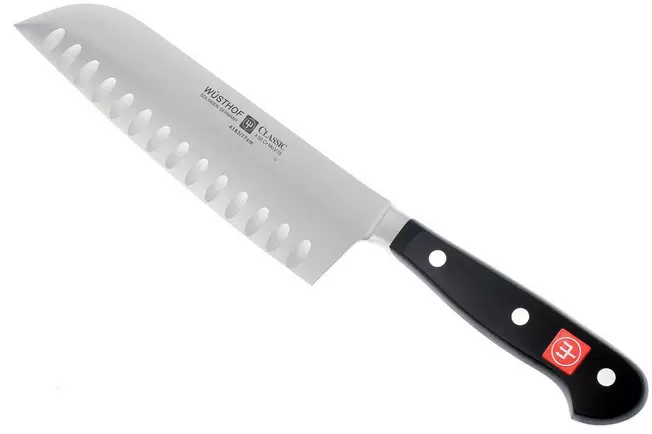
Our score:
4.9/5
#3 – Messermeister Meridian Elite Stealth Chef Knife
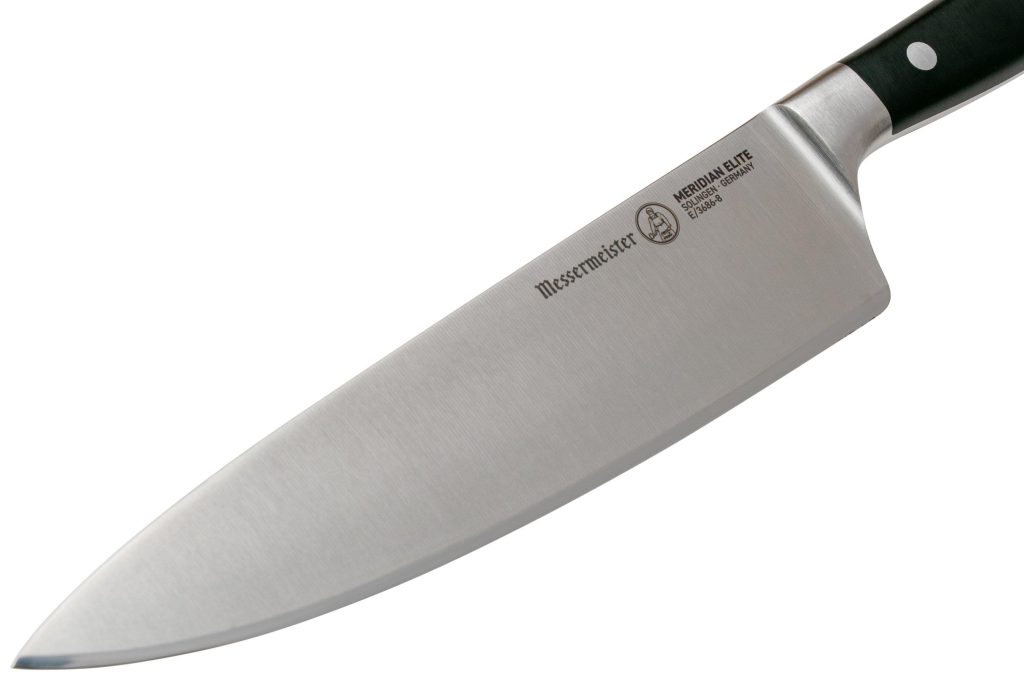
Our score:
4.8/5
When it comes to finding the best chef knives, one must consider various factors such as blade material, handle comfort, and overall performance. In this comprehensive guide, we will discuss some of the top picks in the market that cater to different preferences and skill levels.
We will delve into details about high-quality options like Zwilling J.A. Henckels Professional S Chef Knife with its German stainless steel construction for heavy-duty tasks and Wusthof Classic Ikon Santoku known for its Japanese-style design offering excellent precision cutting capabilities. Additionally, we’ll explore a unique blend of Western and Japanese styles in Messermeister Meridian Elite Stealth Chef Knife which offers lightweight versatility.
Furthermore, our runner-up selections include Global Santoku (G-48) with its fast prep work capabilities and Shun Classic Chef Knife featuring elegant aesthetics. Lastly, our buyer’s guide section will help you make an informed decision by discussing crucial aspects such as carbon vs stainless steel materials, weight distribution considerations, blade length choices along with emphasizing the importance of testing knives in person before making your final choice on the best chef knives suited for your needs.
TIP: Choosing the right chefs knife is also a matter of personal preference. It all depends on how you’re going to use the knife, what weight you prefer and what kind. of things you’re chopping, slicing and dicing.
Top 5 best chefs knives
- Zwilling J.A. Henckels Professional S Chef Knife – Rated 5/5
- Wusthof Classic Ikon Santoku – Rated 4.9/5
- Messermeister Meridian Elite Stealth Chef Knife – Rated 4.8/5
- Global Santoku (G-48) – Rated 4.7/5
- Shun Classic Chef Knife – Rated 4.7/5
1. Zwilling J.A. Henckels Professional S Chef Knife
Our top-of-the-line chefs knife choice
Our pick

The Zwilling J.A. Henckels Professional S Chef Knife is a top-of-the-line choice for those looking to invest in a high-quality knife that will last for years to come.
Constructed with a high-carbon stainless steel blade featuring a satin finish, this Western-style chef’s knife offers reduced drag and improved cutting precision while providing superior strength for handling tough ingredients.
The blade’s satin finish reduces drag when cutting through food items, making it easier to achieve precise cuts with minimal effort.
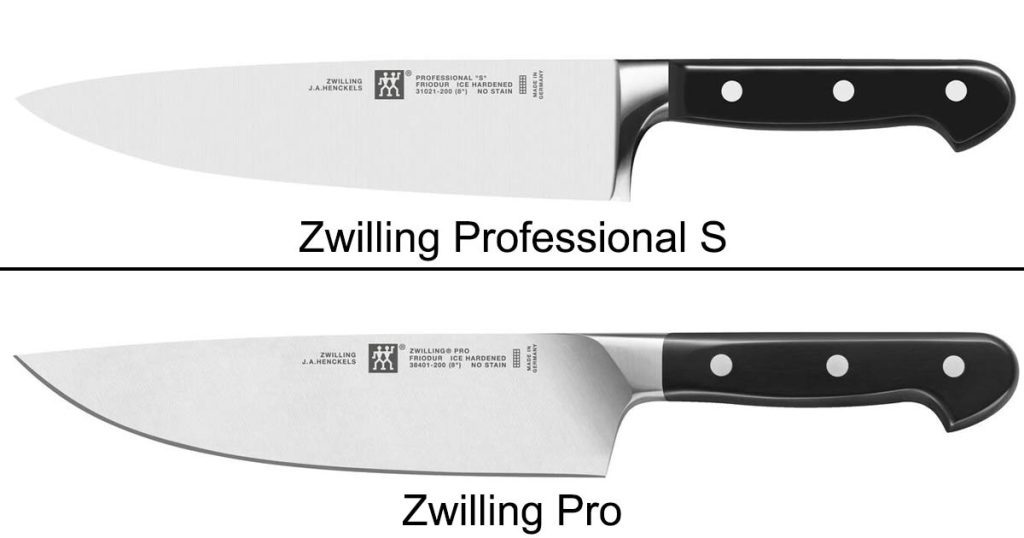
Its thick build quality makes it suitable for handling tough ingredients like large vegetables or dense squash without bending or breaking under pressure.
This chef’s knife excels at slicing and dicing thanks to its curved blade design and sharp edge – qualities often found in both Japanese and Western-style Japanese knives.
- Paring knife: For smaller tasks such as peeling fruits or trimming vegetables, consider adding a paring knife to your collection.
- Serrated knife: A serrated knife is essential for cutting through crusty loaves of bread or slicing delicate pastries without crushing them.
To keep your Zwilling J.A. Henckels Professional S Chef Knife in top condition, regularly hone the blade using a knife sharpener designed specifically for high-quality knives like this one.
Always use a proper cutting board and store your chef’s knife safely away from other utensils when not in use.
If you’re looking for an impressively sharp edge combined with durability and versatility suited for both professional chefs and home cooks alike, consider adding the Zwilling J.A. Henckels Professional S Chef Knife to your knife collection today.
Pros
Cons
2. Wusthof Classic Santoku
The Wusthof Classic Santoku is a top-notch chef’s knife that combines German engineering with Japanese design.

The dimpled blade prevents food from sticking, and the thinness allows for paper-thin tomato slices or perfectly julienned vegetables.
This knife, made from high-carbon stainless steel, offers an enduringly sharp edge that outlasts many others.
Invest in a professional sharpening service or use a quality knife sharpener designed for Japanese-style knives to keep it in top shape.
The comfortable handle design provides excellent grip and control during use, making it perfect for slippery ingredients or delicate tasks.
- Precision cutting: Thin blade allows for precise cuts.
- Dimpled blade: Prevents food from sticking to the knife.
- Durability: High-carbon stainless steel construction ensures long-lasting sharpness and durability.
- Ergonomic handle: Comfortable grip makes it easy to maneuver during intricate tasks.
If you value accuracy in your culinary creations, the Wusthof Classic Santoku is an excellent choice for both professional chefs and home cooks alike.
Pros
Cons
3. Messermeister Meridian Elite Stealth Chef Knife
The Messermeister Meridian Elite Stealth Chef Knife is a versatile tool that combines Western and Japanese styles for a unique and impressive design.

This chef’s knife offers the robustness of Western-style knives and the precision cutting capabilities of Japanese-style blades, making it suitable for various kitchen tasks.
- High-Carbon Stainless Steel: The blade is made from high-carbon stainless steel, providing exceptional sharpness retention and corrosion resistance.
- Ergonomic Handle: The comfortable grip ensures easy handling during extended use in any home kitchen environment.
- Curved Blade Edge: The blade’s edge is designed explicitly for rocking motions on your cutting board, making it versatile for chopping vegetables or carving meat.
With its well-balanced construction, this knife is perfect for slicing through dense flesh or effortlessly breaking down chicken joints.
This knife’s elegant look is sure to enhance any kitchen, making it a favorite of professional chefs and home cooks alike.
Messermeister has gained a reputation for producing high-quality knives favored by many professional chefs and home cooks alike.
To maintain the knife’s sharpness and prolong its lifespan, consider investing in a quality knife sharpener.
Pros
Cons
4. Global Santoku (G-48)
The Global Santoku (G-48) is a high-quality santoku knife that is perfect for both home cooks and professional chefs. It features a sleek, modern design with a comfortable grip and a sharp, durable blade.
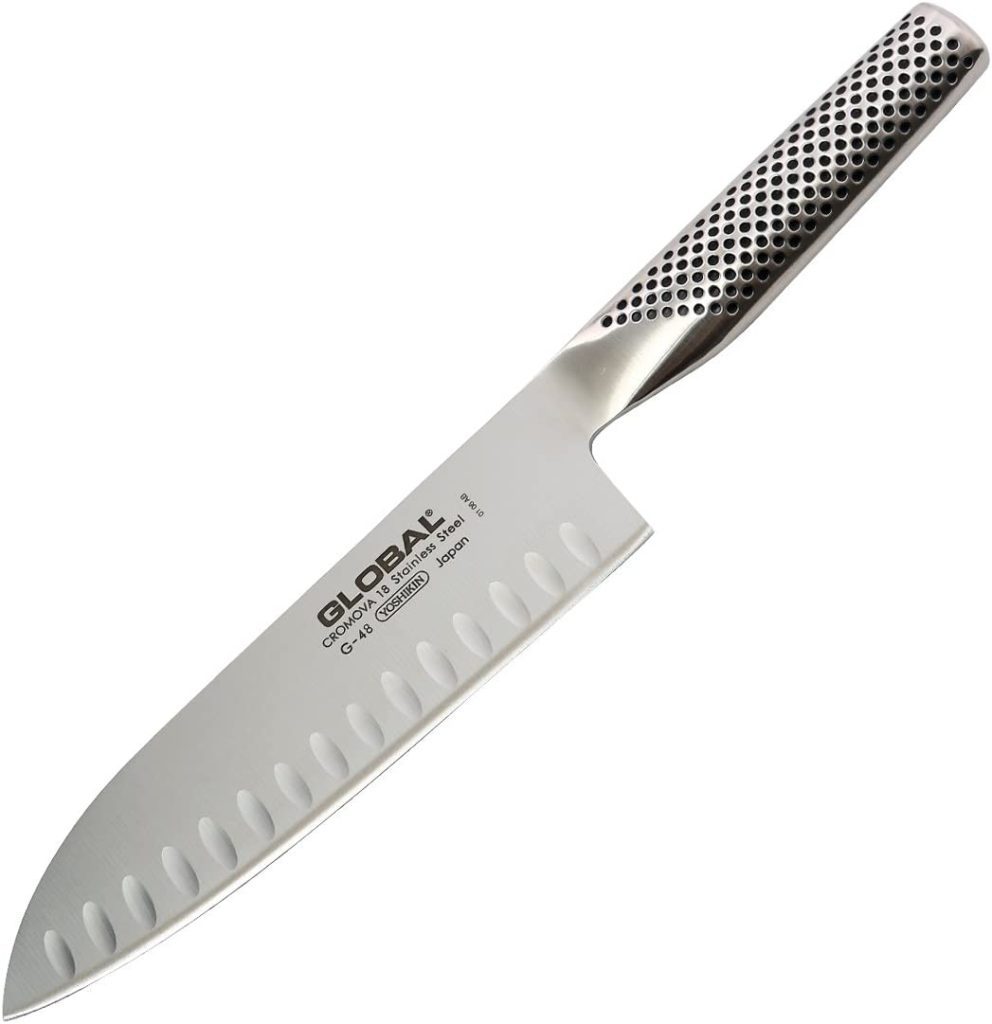
The G-48 is a great choice for anyone who wants a versatile and reliable kitchen knife. It can handle all of your chopping, slicing, and dicing needs with ease, and it looks great doing it!
The knife has a blade length of 7 inches (180 mm), making it shorter than most traditional Santoku knives. This makes it much easier to control when chopping vegetables or slicing meat. The blade is also slightly narrower than most Santoku knives, which makes it ideal for precision work.
The G-48 is made from high-quality stainless steel, which ensures that it will remain sharp for many years to come. The ergonomic handle is made from rosewood and has been designed to provide a comfortable grip even when wet.
With its combination of excellent design, quality materials, and superb craftsmanship, the G-48 is a truly exceptional Santoku knife that is sure to become a kitchen staple.
Pros
Cons
5. Shun Classic Chef Knife
The Shun Classic Chef Knife is one of the most popular knives in the Shun range, and it’s easy to see why. This knife is designed for serious cooks who demand the best performance from their knives.
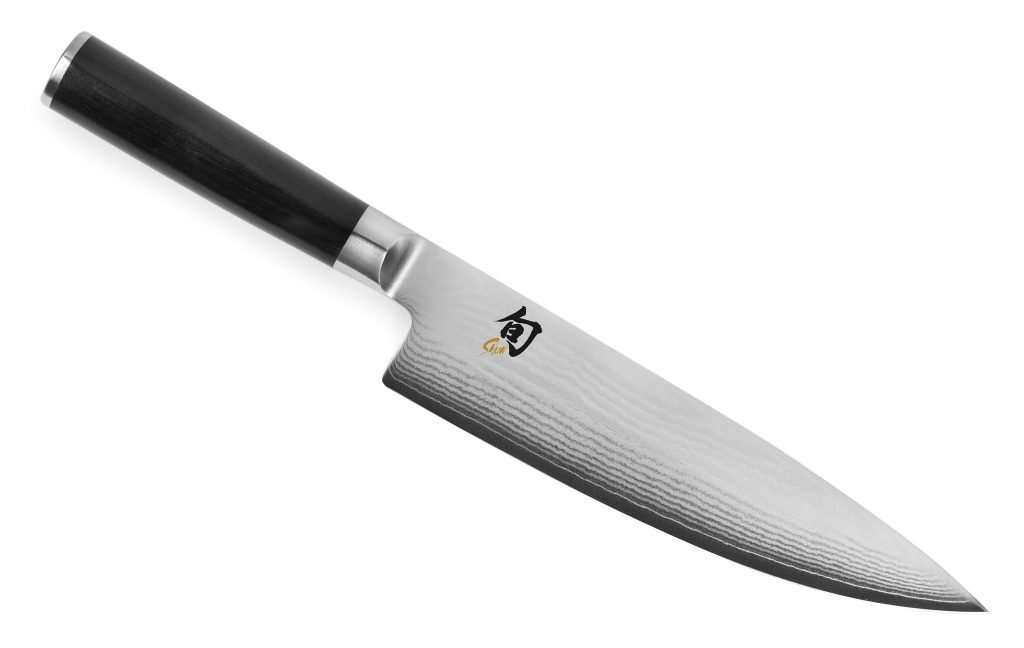
The Shun Classic Chef Knife is made from high-carbon steel, which means it will retain its sharpness for longer than other types of steel. It also has a beautiful hand-hammered finish that adds to its aesthetic appeal. The knife’s blade is tapered so that it’s thinner at the edge, which makes it ideal for slicing and dicing.
The handle on the Shun Classic Chef Knife is made from PakkaWood, a durable synthetic material that’s resistant to moisture and bacteria. The handle is contoured for comfort and has a D-shaped design that fits snugly into the palm of your hand.
Whether you’re chopping vegetables, slicing meat, or mincing herbs, the Shun Classic is up to the task. The knife’s razor-sharp blade is made of high-carbon stainless steel, which holds an edge well and is easy to sharpen. The bolster provides balance and stability while cutting, and the ergonomic PakkaWood handle ensures comfort during extended use.
The Shun Classic also comes with a handy knife sheath for safe storage. Whether you’re looking for your first chef knife or upgrading to a higher-quality option, the Shun Classic is an excellent choice that will provide years of dependable service in your kitchen.
The Shun Classic Chef Knife is a Japanese-style knife that is made with a VG-10 stainless steel blade. The blade is 16 degrees sharpened and has a Rockwell hardness of 60-62. The handle is made from Pakkawood and is riveted to the full tang of the blade. The bolster provides balance and heft, and the end cap protects your hand from slipping onto the blade. The knife weighs 8 ounces and is 13 inches long. The Shun Classic Chef Knife has a lifetime warranty.
The VG-10 stainless steel blade holds an edge well and is easy to sharpen. The Pakkawood handle is comfortable to hold and provides a secure grip. The knife is well balanced and feels good in the hand. It has a good heft to it, but is not too heavy. The Shun Classic Chef Knife slices through meat, vegetables, and fruit with ease. It also chops herbs and nuts finely. This knife lives up to its hype as an all-around versatile kitchen knife that can handle any task you throw at it.
Pros
Cons
Chef’s Knife Buyer’s guide
Attention all foodies and cooking enthusiasts! Are you tired of struggling with dull, unreliable knives in the kitchen? Look no further because we’ve got you covered. In this ultimate guide, we’ll walk you through everything you need to know to choose the perfect chef’s knife for your culinary needs.
From blade materials to handle design and beyond, we’ll equip you with the knowledge and confidence necessary to make an informed purchase that will revolutionize your cooking game. So sharpen those skills (and blades!) as we dive into The Ultimate Guide to Choosing the Perfect Chef’s Knife!
What Is A Chef’s Knife?
A chef’s knife is a kitchen staple that can be used for a variety of tasks, from chopping vegetables to slicing meat. While there are many different types and sizes of knives available, a chef’s knife is typically about 8 inches long and has a broad, sharp blade that tapers to a point.
The handle is usually made of wood or plastic and is ergonomically designed for comfort and grip. A chef’s knife can be an investment piece, so it’s important to choose one that feels good in your hand and is the right size for your needs.
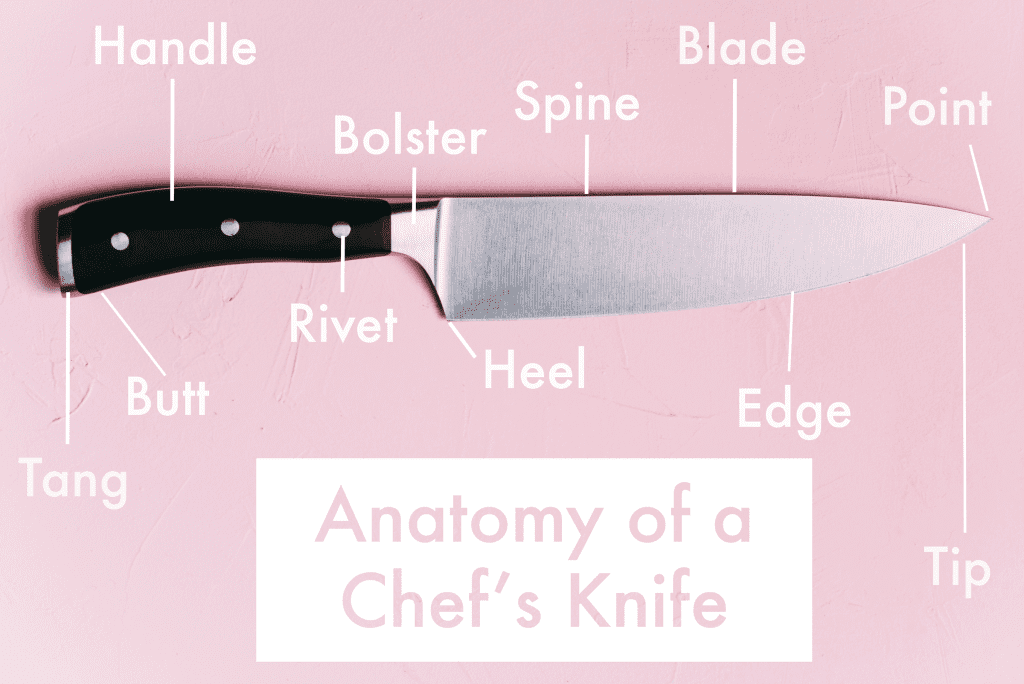
Types of Chef’s Knives
There are many different types of chef’s knives, and each has its own specific purpose. Here is a rundown of the most common types of chef’s knives:
- Boning Knife: This type of knife is used for removing bones from meat. It has a sharp, pointed blade that is ideal for precision work.
- Bread Knife: As the name suggests, this type of knife is used for slicing bread. It has a serrated edge that makes it easy to cut through crusty bread without crushing the inside.
- Carving Knife: This type of knife is used for carving meats such as roast chicken or turkey. It has a long, thin blade that allows you to make precise cuts.
- Chef’s Knife: Also known as a French knife, this is the most versatile type of chef’s knife. It can be used for a variety of tasks such as chopping, slicing, and dicing vegetables.
- Cleaver: This type of knife is typically used for cutting through tough meats such as pork chops or chicken breasts. It has a thick, heavy blade that can handle bone-in meats with ease.
- Paring Knife: This type of knife is used for smaller tasks such as peeling fruits and vegetables or removing seeds from peppers. It has a small, sharp blade that makes it easy to control.
What to Look for When Choosing a Chef’s Knife
When choosing a chef’s knife, it is important to consider the following factors:
-The size of the knife. A chef’s knife typically ranges in size from 8 to 10 inches. Choose a size that feels comfortable in your hand and is appropriate for the tasks you will be using it for.
-The blade material. The most common materials used for chef’s knives are stainless steel and carbon steel. Stainless steel blades are less likely to rust and are easier to care for, while carbon steel blades are sharper and hold their edge longer.
-The handle material. Chef’s knives can have handles made from a variety of materials, including wood, plastic, or metal. Choose a material that feels comfortable in your hand and provides a good grip.
-The price. Chef’s knives can range in price from $30 to $200 or more. Choose a knife that fits your budget and needs.
Blade Size and Shape
When it comes to choosing the perfect chef’s knife, blade size and shape are two of the most important factors to consider. The size of the blade will determine how versatile the knife is for different tasks, while the shape will impact how comfortable it is to use and how well it performs certain cuts.
Here is a breakdown of the most common blade sizes and shapes so you can find the right knife for your needs:
Blade Size
- Small: 6-7 inches
Ideal for peeling and slicing small fruits and vegetables. - Medium: 8-9 inches
Most versatile size that can handle a variety of tasks, from chopping vegetables to slicing meat. - Large: 10+ inches
Best for big jobs like carving a roast or cutting through thick pieces of meat. Not as maneuverable as smaller knives, so take care when using.
Blade Shape
The three most common blade shapes are French, German, and Japanese. Each has its own advantages and disadvantages, so it’s important to choose one that will fit your needs.
- French: Also known as a chef’s knife, this classic style has a straight edge with a pointed tip. It’s extremely versatile and can be used for everything from chopping vegetables to slicing meat. The main downside is that it can be difficult to control if you’re not used to using a knife with this type of blade.
- German: The blade of this style is curved, with a wider belly that makes it easier to rock back and forth when cutting. It’s great for precision work like filleting fish and dicing onions.
- Japanese: This style has a thinner, more pointed blade than the French or German knives. It’s perfect for intricate tasks like making decorative cuts or slicing sushi.
Handle Design
When it comes to choosing a chef’s knife, the handle design is just as important as the blade. After all, you’ll be holding the handle for extended periods of time while you prep meals, so it needs to be comfortable.
There are three main types of handles: Western, Japanese, and ergonomic. Western-style handles are the most common and are typically made of wood or synthetic materials. They’re easy to grip and offer good balance.
Japanese-style handles are usually made of wood or plastic and are shorter than Western-style handles. They offer less fatigue during extended use but can be more challenging to grip if you have large hands.
Ergonomic handles are designed to reduce hand fatigue and offer a more comfortable grip. They’re often made of rubber or other materials that provide good traction.
When choosing a chef’s knife, think about how you want the handle to feel in your hand. If you have large hands, a Western-style handle may be more comfortable. If you have small hands, a Japanese-style handle may be easier to grip. And if you want a knife that’s easy on your hands, an ergonomic handle may be the best option.
Steel Type and Quality
There are a lot of different types of steel used in knives, and it can be confusing trying to figure out which one is best. Here’s a quick rundown of the most common types of steel used in chef’s knives, and what their main characteristics are:
Carbon steel: Carbon steel is a popular choice for chef’s knives because it holds an edge well and is easy to sharpen. However, it is also more prone to rusting than other types of steel, so it requires more maintenance.
Stainless steel: Stainless steel is another popular choice for chef’s knives. It doesn’t rust as easily as carbon steel, but it can be harder to sharpen.
High-carbon stainless steel: This type of steel combines the best of both worlds – it’s resistant to rusting like stainless steel, but holds an edge well like carbon steel. However, it can be more difficult to sharpen than either type of steel on its own.
Damascus steel: Damascus steel is made by stacking layers of different types of metal and forge-welding them together. This creates a beautiful pattern on the blade, and Damascus knives are prized by many chefs for their looks as well as their performance. However, they can be more expensive than other types of knives.
Price Range
When it comes to choosing a chef’s knife, price is often a determining factor. But, as with anything else, you get what you pay for—to a certain extent. A good quality chef’s knife can range anywhere from $100 to $300. Of course, there are always cheaper options available, but they may not be made from the best materials or hold their edge as well. On the other hand, the most expensive knives aren’t always the best either. It’s important to find a balance that works for you and your budget.
In general, German-made knives are on the higher end of the price spectrum, while Japanese knives tend to be more affordable. If you’re looking for something in between, Chinese-made knives offer good quality at a mid-range price point. Of course, there are always exceptions to these generalizations, so it’s important to do your research before making any decisions.
No matter what your budget is, there is a chef’s knife out there that will suit your needs. The most important thing is to find one that feels comfortable in your hand and is the right size for you. With so many options on the market today, there’s no reason not to find the perfect knife for you—no matter what your budget may be.
How to Care for Your Chef’s Knife
Your chef’s knife is one of the most important tools in your kitchen, so it’s important to take care of it. Here are some tips on how to care for your chef’s knife:
- Keep it sharp: A sharp knife is a safe knife, so make sure to keep your chef’s knife sharpened. You can use a honing rod or sharpening stone to sharpen your knife at home, or you can take it to a professional.
- Store it properly: When you’re not using your chef’s knife, make sure to store it properly. The best way to store a chef’s knife is in a sheath or on a magnetic Knife rack. This will protect the blade and keep it from dulling.
- Clean it after each use: It’s important to clean your chef’s knife after each use. Wash it with hot water and soap, and then dry it off with a clean towel. You should also oil the blade occasionally to prevent rusting.
Conclusion
Choosing the perfect chef’s knife can be a daunting task, but with our guide you should feel more confident in making the right choice.
We have taken all of the guesswork out for you by breaking down all of the features to consider when shopping for a chef’s knife and providing some great recommendations to help get your cooking journey started. Now that you know what to look for in a good quality chef’s knife, it is time to go forth and find your own!
Frequently asked questions
What is Gordon Ramsay’s Favorite Chef’s Knife?
Gordon Ramsay’s favorite knife brand is Wusthof. He specifically uses the Wusthof Classic 10-inch Cook’s Knife for most tasks in his kitchen due to its quality construction from high-carbon stainless steel and precision-forged design that ensures long-lasting sharpness.
What are the Characteristics of the Best Chef’s Knife?
A high-quality chef’s knife should have sharpness retention, durability, comfortable grip, balanced weight distribution, good edge geometry, and versatility in cutting various ingredients. Both carbon steel and stainless steel knives can be excellent choices depending on individual needs.
